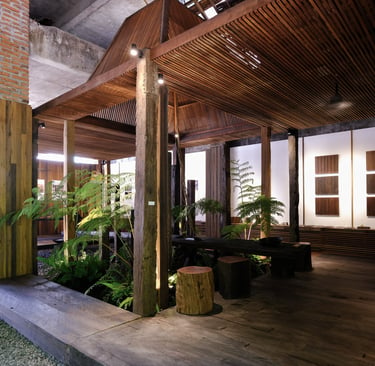Precision Processing
We provide expert wood processing solutions, transforming reclaimed hardwood into precision-crafted products for construction and interior design.
Whether in-house or through trusted partners, our services ensure durability, quality, and aesthetic appeal.
We transform our reclaimed wood into high-quality products, crafted in-house or with our trusted partners:
Decking – Multiple profiles available (E2E, E4E, Groove & Groove, custom), ideal for outdoor spaces.
Flooring – Tongue & Groove (T&G), shiplap, and custom profiles for durable and stylish interiors.
Panelling – Wall cladding solutions for interior and exterior applications, commonly in shiplap, shiplap reveal, or T&G profiles.
Ceiling – Elegant reclaimed wood panels to add warmth and character overhead, typically in T&G or square-edge profiles.
Lumber – Premium reclaimed hardwood for custom projects and structural applications.
Countertops – Solid wood surfaces for kitchens, bars, and workspaces.
Doors – Custom wood doors for timeless elegance and durability.
Windows – High-quality reclaimed wood frames for a natural touch.
Stair Steps – Durable and stylish wooden stair components.
Rafters, Joists, and Battens – Structural wood elements for construction and framing.
Balustrades and Handrails – Elegant and sturdy railing solutions for stairs and balconies.
Shutters – Functional and decorative reclaimed wood shutters for windows and exteriors.
Skirting and Cornices – Finishing details for seamless and refined interiors.
Pergolas – Custom wood pergolas for shaded outdoor living spaces.


Understanding Wood Processing: A Comprehensive Guide
Write your text here...Wood processing encompasses a series of operations that transform raw timber into usable products for construction, furniture, and various industries. This guide addresses common questions to provide a deeper insight into the wood processing industry.
1. What is Wood Processing?
Wood processing refers to the series of operations that convert raw timber into usable products such as lumber, plywood, paper, and furniture. This process includes stages like harvesting, debarking, sawing, drying, and finishing. The goal is to enhance the wood's properties, making it suitable for various applications.
2. What is Wood Processing in Basic Technology?
In basic technology, wood processing involves fundamental techniques to transform raw wood into functional products. This includes manual methods like hand sawing, planing, and chiseling, as well as the use of simple machines. These foundational skills are essential for carpentry, joinery, and other wood-related crafts.
3. What is a Wood Processing Plant?
A wood processing plant is an industrial facility where raw timber is processed into various wood products. Operations typically include debarking, sawing logs into lumber, drying, planing, and sometimes chemical treatments to enhance durability. These plants supply materials for construction, furniture manufacturing, and paper production.
4. What is the Wood Processing Industry?
The wood processing industry encompasses all enterprises involved in converting raw timber into finished products. This includes sawmills, plywood mills, pulp and paper mills, and furniture manufacturers. The industry plays a crucial role in the economy by providing materials for construction, packaging, and various consumer goods.
5. Wood Processing for Furniture
Wood processing for furniture involves selecting suitable timber, seasoning to reduce moisture content, cutting, shaping, joining, and finishing. High-quality craftsmanship ensures durability and aesthetic appeal. Techniques such as mortise and tenon joints, dovetailing, and veneering are commonly employed to create functional and decorative pieces.
6. Wood Processing Near Me
Finding wood processing services nearby depends on your location. Local sawmills, carpentry workshops, or lumber yards often offer processing services such as cutting, planing, and custom milling. It's advisable to search online directories or contact local trade associations for recommendations. Kitaru is located Jl. Pantai Saba No.47509, Saba, Kec. Blahbatuh, Kabupaten Gianyar, Bali 80581.
7. Wood Processing Companies
Wood processing companies specialize in converting raw timber into various products. These range from small-scale artisanal workshops to large industrial operations. Services may include lumber production, veneer slicing, plywood manufacturing, and custom woodworking. Choosing a company depends on the specific requirements of your project.
8. What equipment is used in wood processing?
Wood processing utilizes a variety of equipment, including:
Saws: For cutting logs into desired shapes and sizes.
Planers: To smooth and flatten wood surfaces.
Sanding machines: For finishing surfaces to a fine texture.
Lathes: Used for shaping wood into cylindrical forms.
CNC machines: Computer-controlled tools that allow for precise and intricate designs.
9. Wood Processing Equipment
Wood processing equipment encompasses machinery used at various stages, including saws, planers, sanders, lathes, and CNC machines. Advanced equipment improves efficiency, precision, and safety in processing operations. Investing in modern machinery is crucial for companies aiming to enhance productivity and product quality.
10. What are the different types of wood processing techniques?
Wood processing techniques vary based on the desired end product and include:
Sawing: Cutting logs into boards or planks.
Planing: Smoothing and leveling wood surfaces.
Turning: Shaping wood on a lathe to create round objects.
Carving: Artistic shaping of wood using hand tools or machines.
Laminating: Bonding multiple layers of wood to enhance strength and stability.
Understanding wood processing is essential for anyone involved in woodworking, construction, or related industries. From basic techniques to industrial operations, the processes ensure that raw timber is effectively transformed into valuable products that meet diverse needs.



